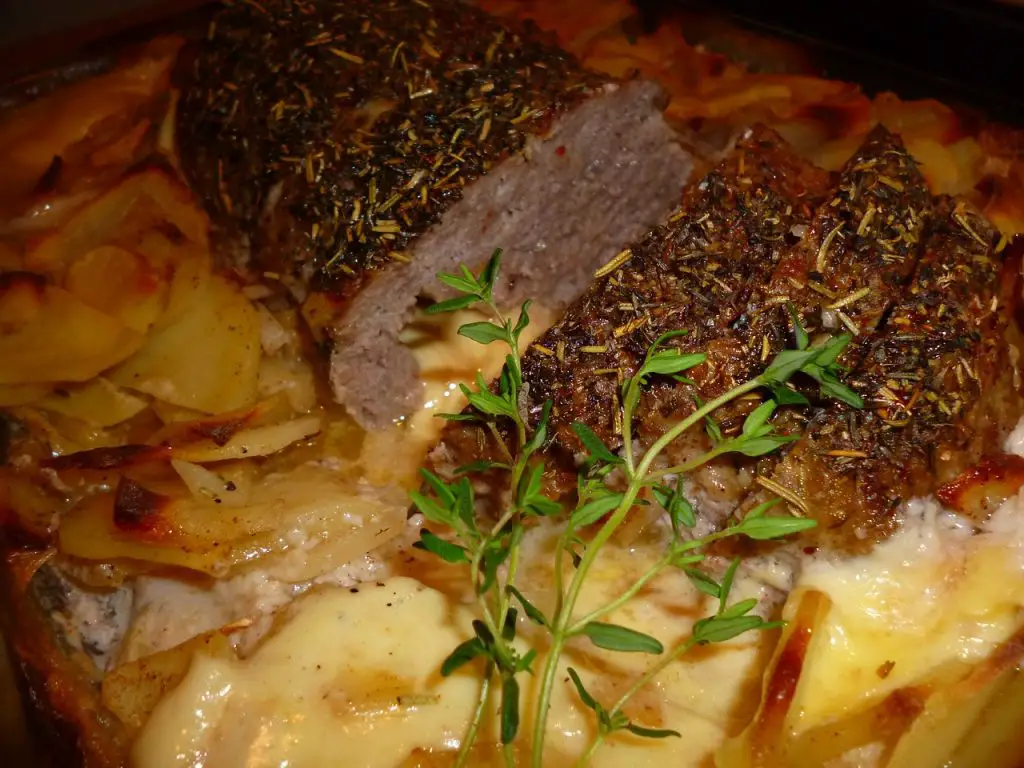Meatloaf, a beloved American classic, has been gracing dinner tables for generations. Its hearty, savory flavors and simplicity make it a go-to comfort food for many. Whether you’re a seasoned home cook or just starting your culinary journey, this easy meatloaf recipe is sure to become a staple in your kitchen.
In this comprehensive guide, we’ll walk you through the steps to create a delectable meatloaf that’s moist, flavorful, and effortlessly easy to make. From choosing the right ingredients to mastering the cooking techniques, you’ll soon be serving up meatloaf that will have your family and friends asking for seconds.
Ingredients
Before you dive into making the perfect meatloaf, it’s essential to gather the right ingredients. Here’s what you’ll need for this easy meatloaf recipe:
2 pounds ground beef: Aim for 80% lean, as it provides a good balance of flavor and moisture.
1 cup breadcrumbs: Use plain breadcrumbs to help bind the meatloaf and absorb excess moisture.
1 cup milk: Whole milk works best, but you can use 2% if you prefer a lighter option.
1/2 cup ketchup: Adds a tangy, sweet flavor to the meatloaf and forms a delicious glaze on top.
1/2 cup finely chopped onion: For added flavor and moisture.
1/2 cup finely chopped bell pepper (optional): This provides a hint of sweetness and color.
2 cloves garlic, minced: Garlic enhances the overall flavor of the meatloaf.
2 large eggs: Acts as a binding agent, holding the meatloaf together.
1 tablespoon Worcestershire sauce: Adds a depth of savory flavor.
1 teaspoon salt: Enhances the taste of the meatloaf.
1/2 teaspoon black pepper: Provides a subtle kick of heat.
1/2 teaspoon dried thyme (optional): Aromatic herbs can elevate the dish.
Now that you have your ingredients ready, let’s get started with the step-by-step instructions.
Instructions
Preheat your oven: Preheat your oven to 350°F (175°C) to ensure it’s ready when your meatloaf is prepared for baking.
Combine the breadcrumbs and milk: In a large mixing bowl, pour the milk over the breadcrumbs and allow them to soak for a few minutes. This step helps keep the meatloaf moist.
Mix the meat and seasonings: Add the ground beef, chopped onions, bell pepper (if using), minced garlic, eggs, Worcestershire sauce, salt, black pepper, and dried thyme (if desired) to the breadcrumb mixture. Using clean hands, gently mix everything together. Avoid overmixing, as it can lead to a denser meatloaf.
Form the meatloaf: Transfer the meat mixture onto a baking sheet or into a loaf pan. Shape it into a loaf shape, ensuring it’s evenly distributed.
Add the ketchup glaze: Spread a generous layer of ketchup over the top of the meatloaf. This will not only add flavor but also create a caramelized glaze as it bakes.
Bake the meatloaf: Place the meatloaf in the preheated oven and bake for approximately 1 hour or until the internal temperature reaches 160°F (71°C). You can use a meat thermometer to check the temperature.
Rest and serve: Once done, remove the meatloaf from the oven and let it rest for about 10 minutes before slicing. This allows the juices to redistribute, resulting in a moister meatloaf.
Serving Suggestions
Your easy meatloaf is now ready to be served, and there are numerous delicious ways to enjoy it:
Traditional: Serve slices of meatloaf with classic sides like mashed potatoes and green beans for a comforting, homey meal.
Meatloaf sandwiches: Make meatloaf sandwiches by placing slices between two pieces of bread or in a bun, adding lettuce, tomato, and a dollop of extra ketchup or mayonnaise.
Meatloaf and gravy: Pour homemade or store-bought gravy over slices of meatloaf and serve it with creamy mashed potatoes and steamed vegetables.
Meatloaf sliders: Turn your meatloaf into bite-sized sliders by cutting it into smaller portions and placing them on mini buns. Top with cheese, pickles, and your favorite condiments.
Meatloaf leftovers: Meatloaf makes fantastic leftovers. Use it in sandwiches, crumble it into pasta sauce, or even top a pizza with meatloaf slices.
Tips for a Perfect Meatloaf
Achieving the perfect meatloaf may take a bit of practice, but with these tips, you’ll be well on your way:
Don’t overmix: Be gentle when mixing the ingredients. Overmixing can result in a denser, less tender meatloaf.
Use a meat thermometer: To ensure your meatloaf is fully cooked without drying out, invest in a meat thermometer and aim for an internal temperature of 160°F (71°C).
Let it rest: Allow your meatloaf to rest after baking. This helps the juices redistribute, making the meatloaf more succulent.
Experiment with flavors: Feel free to customize your meatloaf by adding herbs, spices, or even different types of ground meat, like a blend of beef and pork.
Get creative with toppings: Try different glazes or toppings for your meatloaf, such as barbecue sauce, brown sugar, or a combination of ketchup and brown sugar for a sweet and tangy twist.
Use a loaf pan or baking sheet: You can shape your meatloaf on a baking sheet for a more rustic appearance or use a loaf pan for a neater presentation.
Mastering an easy meatloaf recipe is a fantastic addition to your culinary repertoire. This classic dish offers both simplicity and versatility, making it a go-to option for weeknight dinners or special occasions. With the right ingredients, proper techniques, and a bit of creativity, you can craft a mouthwatering meatloaf that will have everyone at the table asking for seconds. So, roll up your sleeves, gather your ingredients, and enjoy the delicious journey of making your own perfect meatloaf.
Variations and Customizations
While the classic meatloaf recipe outlined above is a tried-and-true favorite, there are countless ways to customize and experiment with this dish to suit your taste preferences. Here are some ideas for variations:
Ground Meat Blend: Instead of using only ground beef, try mixing different ground meats. A combination of beef, pork, and veal can create a rich and flavorful meatloaf known as “meatloaf mix.” You can also use ground turkey or chicken for a lighter option.
Vegetables: Feel free to add more vegetables to the mix. Grated carrots, spinach, mushrooms, or zucchini can all add moisture, flavor, and extra nutrients to your meatloaf.
Herbs and Spices: Experiment with various herbs and spices to change up the flavor profile. Fresh herbs like parsley, basil, or oregano can infuse a burst of freshness into your meatloaf. Add cayenne pepper for some heat, or try smoked paprika for a smoky twist.
Cheese: Incorporate shredded cheese into the meat mixture for added creaminess and flavor. Cheddar, mozzarella, or Parmesan are excellent choices.
Glaze and Sauces: Try different glazes and sauces to top your meatloaf. Barbecue sauce, honey mustard, or a sweet and sour glaze can provide unique and delightful flavors.
Nutritional Additions: Boost the nutritional value of your meatloaf by mixing in rolled oats, quinoa, or cooked lentils. These additions can increase the fiber content and make the dish even more satisfying.
Toppings: Instead of the traditional ketchup glaze, explore other topping options like a mushroom gravy, caramelized onions, or a balsamic reduction.
Stuffed Meatloaf: Create a surprise inside your meatloaf by stuffing it with ingredients like spinach and feta cheese, roasted red peppers, or even hard-boiled eggs.
Mini Meatloaves: Form individual-sized mini meatloaves for a fun twist on the classic recipe. They cook faster and are perfect for portion control.
International Flavors: Infuse your meatloaf with international flavors. Consider adding soy sauce, ginger, and sesame oil for an Asian-inspired twist, or use taco seasoning and salsa for a Mexican-inspired meatloaf.
Common Mistakes to Avoid
To ensure your meatloaf turns out perfect every time, here are some common mistakes to avoid:
Overmixing: As mentioned earlier, overmixing the ingredients can lead to a dense meatloaf. Mix just until everything is combined.
Using Lean Meat: Using lean ground meat can result in a dry meatloaf. Opt for ground beef with some fat content, typically around 80% lean.
Skipping the Rest: Allowing the meatloaf to rest after baking is crucial for juiciness. Cutting it immediately can cause the juices to run out, leaving you with a drier result.
Forgetting the Meat Thermometer: Always check the internal temperature of your meatloaf with a meat thermometer to ensure it’s fully cooked. Cutting into it to check can result in moisture loss.
Not Seasoning Adequately: Be sure to season your meatloaf well. Taste the mixture before baking to ensure it has enough salt and other seasonings.
Using Stale Breadcrumbs: Fresh breadcrumbs work best, as stale ones can absorb too much moisture, resulting in a dry meatloaf.
With this easy meatloaf recipe and the tips and variations provided, you have all the tools you need to create a mouthwatering meatloaf that suits your taste and preferences. Whether you choose to stick with the classic version or experiment with different ingredients and flavors, meatloaf is a versatile and comforting dish that can be a hit at any dinner table.
So, roll up your sleeves, gather your ingredients, and embark on the journey of crafting the perfect meatloaf. Whether you’re serving it as a weeknight family dinner or as the centerpiece of a special occasion, your homemade meatloaf is sure to bring smiles and satisfaction to those lucky enough to enjoy it.
Troubleshooting Common Meatloaf Issues
Even with the best of intentions, sometimes things don’t go according to plan in the kitchen. Here are some common issues that may arise while making meatloaf and how to troubleshoot them:
Dry Meatloaf: If your meatloaf turns out dry, it’s often due to using lean ground meat or overcooking. To avoid this, use ground beef with some fat content and be vigilant with the cooking time. You can also add more moisture by incorporating additional milk or even a bit of beef broth into the meat mixture.
Falling Apart: If your meatloaf falls apart when you slice it, it’s likely due to not having enough binding agents. To prevent this, ensure you use enough eggs and breadcrumbs in your recipe. Alternatively, you can let the meatloaf cool slightly before slicing, which will make it hold together better.
Too Dense: An overly dense meatloaf is often a result of overmixing the ingredients. To achieve a lighter texture, be gentle when mixing and avoid compacting the meat mixture too much. Also, consider incorporating more breadcrumbs or adding vegetables for moisture.
Lack of Flavor: If your meatloaf lacks flavor, it could be due to insufficient seasoning. Taste the mixture before baking and adjust the seasonings accordingly. Experiment with different herbs, spices, and condiments to find the flavor profile you prefer.
Burnt Top: If the top of your meatloaf is getting too brown or burnt during baking, cover it with aluminum foil for the remaining cooking time. This will prevent further browning while ensuring the interior continues to cook.
Soggy Bottom: A soggy bottom can occur if excess moisture is not properly absorbed by the breadcrumbs. To avoid this, make sure the breadcrumbs are fully hydrated with the milk before adding them to the meat mixture. Additionally, consider using a baking rack to elevate the meatloaf slightly above the pan to allow excess moisture to drip away.
Taste of Raw Onions: If the taste of raw onions is too strong in your meatloaf, consider sautéing them in a little butter or oil until they become translucent before adding them to the meat mixture. This will mellow their flavor and enhance their sweetness.
Too Salty: If your meatloaf turns out too salty, it can be challenging to fix after it’s cooked. To prevent this, be cautious with the amount of salt you add, and consider using low-sodium ingredients if you are concerned about sodium intake.
Uneven Cooking: To ensure even cooking, shape your meatloaf uniformly. If you are making a larger meatloaf, consider dividing the mixture into smaller loaves or using a meatloaf pan with a built-in rack to promote even airflow around the meat.
Leftover Storage: When storing leftover meatloaf, wrap it tightly in plastic wrap or aluminum foil and place it in an airtight container. It can be refrigerated for up to 3-4 days or frozen for up to 2-3 months.
In conclusion, mastering the art of making a perfect meatloaf takes practice and experimentation. The key is to learn from your experiences, adjust your approach based on the results, and have fun exploring different flavors and variations. With these tips and troubleshooting advice in mind, you’ll be well on your way to becoming a meatloaf aficionado, capable of crafting delicious and satisfying meals for yourself and your loved ones.




